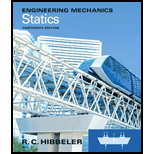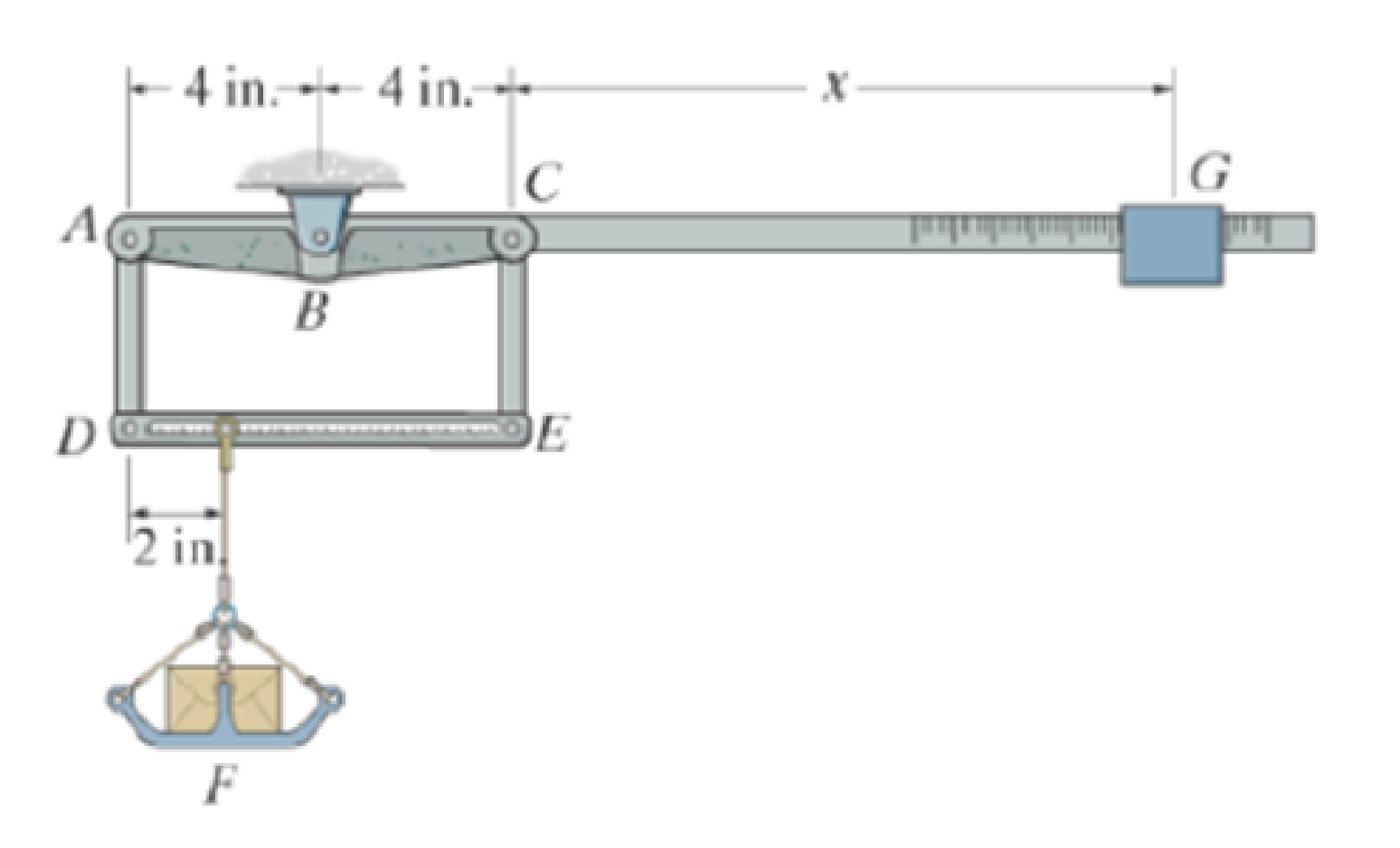
Engineering Mechanics: Statics
13th Edition
ISBN: 9780132915540
Author: Russell C. Hibbeler
Publisher: Prentice Hall
expand_more
expand_more
format_list_bulleted
Concept explainers
Textbook Question
Chapter 11.3, Problem 21P
If the load F weighs 20 lb and the block G weighs 2 lb. determine its position x for equilibrium of the differential lever. The lever is in balance when the load and block are not on the lever.

Expert Solution & Answer
Want to see the full answer?
Check out a sample textbook solution
Students have asked these similar questions
The gears shown in the figure have a diametral pitch of 2 teeth per inch and a 20° pressure angle.
The pinion rotates at 1800 rev/min clockwise and transmits 200 hp through the idler pair to gear
5 on shaft c. What forces do gears 3 and 4 transmit to the idler shaft?
TS
I
y
18T
32T
This
a
12
x
18T
C
48T
5
Question 1. Draw 3 teeth for the following pinion and gear respectively. The teeth
should be drawn near the pressure line so that the teeth from the pinion should
mesh those of the gear. Drawing scale (1:1). Either a precise hand drawing or
CAD drawing is acceptable. Draw all the trajectories of the involute lines and the
circles.
Specification: 18tooth pinion and 30tooth gear. Diameter pitch=P=6 teeth /inch.
Pressure angle:20°, 1/P for addendum (a) and 1.25/P for dedendum (b). For fillet,
c=b-a.
5. The figure shows a gear train. There is no friction at the bearings except for the gear tooth forces.
The material of the milled gears is steel having a Brinell hardness of 170. The input shaft speed (n2)
is 800 rpm. The face width and the contact angle for all gears are 1 in and 20° respectively. In this
gear set, the endurance limit (Se) is 15 kpsi and nd (design factor) is 2.
(a) Find the revolution speed of gear 5.
(b) Determine whether each gear satisfies the design factor of 2.0 for bending fatigue.
(c) Determine whether each gear satisfies the design factor of 2.0 for surface fatigue (contact stress).
(d) According to the computation results of the questions (b) and (c), explain the possible failure
mechanisms for each gear.
N4=28
800rpm
N₁=43
N5=34
N₂=14
P(diameteral pitch)=8 for all gears
Coupled to 2.5hp motor
Chapter 11 Solutions
Engineering Mechanics: Statics
Ch. 11.3 - Each link has a mass of 20 kg.Ch. 11.3 - Determine the magnitude of force P required to...Ch. 11.3 - Determine the angle for equilibrium. The spring...Ch. 11.3 - Determine the angle for equilibrium. The spring...Ch. 11.3 - Prob. 5FPCh. 11.3 - Determine the angle for equilibrium. The spring...Ch. 11.3 - Each of the four links has a length L and is pin...Ch. 11.3 - The lamp weighs 10 lb.Ch. 11.3 - Prob. 3PCh. 11.3 - Prob. 4P
Ch. 11.3 - Prob. 5PCh. 11.3 - Prob. 6PCh. 11.3 - It vertical forces P1 = P2 = 30 lb act at C and E...Ch. 11.3 - Prob. 8PCh. 11.3 - if the uniform inks AB and CD each weigh 10 lb....Ch. 11.3 - Prob. 10PCh. 11.3 - Prob. 11PCh. 11.3 - Prob. 12PCh. 11.3 - Prob. 13PCh. 11.3 - Prob. 14PCh. 11.3 - Prob. 15PCh. 11.3 - Prob. 16PCh. 11.3 - Prob. 17PCh. 11.3 - Prob. 18PCh. 11.3 - Prob. 19PCh. 11.3 - The lever is in balance when the load and block...Ch. 11.3 - If the load F weighs 20 lb and the block G weighs...Ch. 11.3 - Determine the force in the hydraulic cylinder...Ch. 11.3 - Determine the horizontal compressive force F...Ch. 11.3 - Prob. 24PCh. 11.3 - Prob. 25PCh. 11.7 - Prob. 26PCh. 11.7 - If the potential function for a conservative...Ch. 11.7 - Prob. 28PCh. 11.7 - Determine the equilibrium positions and...Ch. 11.7 - Prob. 30PCh. 11.7 - Prob. 31PCh. 11.7 - Determine the angle for equilibrium when a weight...Ch. 11.7 - Prob. 33PCh. 11.7 - Prob. 34PCh. 11.7 - Prob. 35PCh. 11.7 - The bars each have a mass of 3 Kg one the...Ch. 11.7 - Prob. 37PCh. 11.7 - Prob. 38PCh. 11.7 - Prob. 39PCh. 11.7 - It is unstretched when the rod assembly is in the...Ch. 11.7 - Prob. 41PCh. 11.7 - Determine the weight W2, that is on the pan in...Ch. 11.7 - Prob. 43PCh. 11.7 - Determine the steepest grade along which it can...Ch. 11.7 - Prob. 45PCh. 11.7 - Prob. 46PCh. 11.7 - Point C is coincident with B when OA is...Ch. 11.7 - If the block has three equal sides of length d,...Ch. 11.7 - Prob. 49PCh. 11.7 - Prob. 50RPCh. 11.7 - Prob. 51RPCh. 11.7 - Prob. 52RPCh. 11.7 - Prob. 53RPCh. 11.7 - Prob. 54RPCh. 11.7 - Prob. 55RPCh. 11.7 - Prob. 56RPCh. 11.7 - Prob. 57RPCh. 11.7 - Prob. 58RPCh. 11.7 - If both spring DE and BC are unstretched when =...Ch. 11.7 - Prob. 60RPCh. 11.7 - Prob. 61RPCh. 11.7 - Determine the horizontal force P required to hold...
Knowledge Booster
Learn more about
Need a deep-dive on the concept behind this application? Look no further. Learn more about this topic, mechanical-engineering and related others by exploring similar questions and additional content below.Similar questions
- 1. The rotating steel shaft is simply supported by bearings at points of B and C, and is driven by a spur gear at D, which has a 6-in pitch diameter. The force F from the drive gear acts at a pressure angle of 20°. The shaft transmits a torque to point A of TA =3000 lbĘ in. The shaft is machined from steel with Sy=60kpsi and Sut=80 kpsi. (1) Draw a shear force diagram and a bending moment diagram by F. According to your analysis, where is the point of interest to evaluate the safety factor among A, B, C, and D? Describe the reason. (Hint: To find F, the torque Tд is generated by the tangential force of F (i.e. Ftangential-Fcos20°) When n=2.5, K=1.8, and K₁ =1.3, determine the diameter of the shaft based on (2) static analysis using DE theory (note that fatigue stress concentration factors need to be used for this question because the loading condition is fatigue) and (3) a fatigue analysis using modified Goodman. Note) A standard diameter is not required for the questions. 10 in Darrow_forward3 N2=28 P(diametral pitch)=8 for all gears Coupled to 25 hp motor N3=34 Full depth spur gears with pressure angle=20° N₂=2000 rpm (1) Compute the circular pitch, the center-to-center distance, and base circle radii. (2) Draw the free body diagram of gear 3 and show all the forces and the torque. (3) In mounting gears, the center-to-center distance was reduced by 0.1 inch. Calculate the new values of center-to-center distance, pressure angle, base circle radii, and pitch circle diameters. (4)What is the new tangential and radial forces for gear 3? (5) Under the new center to center distance, is the contact ratio (mc) increasing or decreasing?arrow_forward2. A flat belt drive consists of two 4-ft diameter cast-iron pulleys spaced 16 ft apart. A power of 60 hp is transmitted by a pulley whose speed is 380 rev/min. Use a service factor (Ks) pf 1.1 and a design factor 1.0. The width of the polyamide A-3 belt is 6 in. Use CD=1. Answer the following questions. (1) What is the total length of the belt according to the given geometry? (2) Find the centrifugal force (Fc) applied to the belt. (3) What is the transmitted torque through the pulley system given 60hp? (4) Using the allowable tension, find the force (F₁) on the tight side. What is the tension at the loose side (F2) and the initial tension (F.)? (5) Using the forces, estimate the developed friction coefficient (f) (6) Based on the forces and the given rotational speed, rate the pulley set. In other words, what is the horse power that can be transmitted by the pulley system? (7) To reduce the applied tension on the tight side, the friction coefficient is increased to 0.75. Find out the…arrow_forward
- The tooth numbers for the gear train illustrated are N₂ = 24, N3 = 18, №4 = 30, №6 = 36, and N₁ = 54. Gear 7 is fixed. If shaft b is turned through 5 revolutions, how many turns will shaft a make? a 5 [6] barrow_forwardCE-112 please solve this problem step by step and give me the correct answerarrow_forwardCE-112 please solve this problem step by step and give me the correct answerarrow_forward
- CE-112 solve this problem step by step and give me the correct answer pleasearrow_forwardPlease do not use any AI tools to solve this question. I need a fully manual, step-by-step solution with clear explanations, as if it were done by a human tutor. No AI-generated responses, please.arrow_forwardPlease do not use any AI tools to solve this question. I need a fully manual, step-by-step solution with clear explanations, as if it were done by a human tutor. No AI-generated responses, please.arrow_forward
arrow_back_ios
SEE MORE QUESTIONS
arrow_forward_ios
Recommended textbooks for you
 International Edition---engineering Mechanics: St...Mechanical EngineeringISBN:9781305501607Author:Andrew Pytel And Jaan KiusalaasPublisher:CENGAGE L
International Edition---engineering Mechanics: St...Mechanical EngineeringISBN:9781305501607Author:Andrew Pytel And Jaan KiusalaasPublisher:CENGAGE L

International Edition---engineering Mechanics: St...
Mechanical Engineering
ISBN:9781305501607
Author:Andrew Pytel And Jaan Kiusalaas
Publisher:CENGAGE L
Physics - Thermodynamics: (21 of 22) Change Of State: Process Summary; Author: Michel van Biezen;https://www.youtube.com/watch?v=AzmXVvxXN70;License: Standard Youtube License